Organic vs. Conventional Watermelon for Fermenting the Rind
I suggest using an organic in-season watermelon to make fermented watermelon rind. People often say that conventional watermelons are just as good as organic ones. However, that is because the rind protects the watermelon flesh from absorbing pesticides. Getting an organic watermelon is important since we are using the rind in this recipe, not the flesh.
You can use any type of watermelon and any size to make fermented watermelon rind.
Here’s my checklist for choosing a good watermelon:
- Observe the stripes: Watermelon colors indicate ripeness. You should pick a melon that has a strong, consistent stripe pattern. The green stripes should be mostly solid green, while the pale stripes should be light yellow.
- Field Spot: The field spot of the melon shows where the watermelon sat on the ground as it ripened. This is where soil microbes colonized the watermelon, and these microbes are vital to fermentation. Inspect your watermelon and locate a large, discolored spot on the surface. The color is usually yellow or near orange, which indicates a melon full of flavor. A good field spot means the rind is full of flavor too.
- Check the Stem: This is for readers growing melons in their garden. When a watermelon has had sufficient time to ripen and mature, the stem should be dry and yellow-brown. A green stem means the watermelon is not yet ripe.
- Dry spots: You may think you don’t want a melon with blemished rind for this recipe, but you do. Dry weathering spots and vein-like webbing on the rind indicate an extra sweet watermelon because these “blemishes” show where sugar has been seeping out of the fruit.
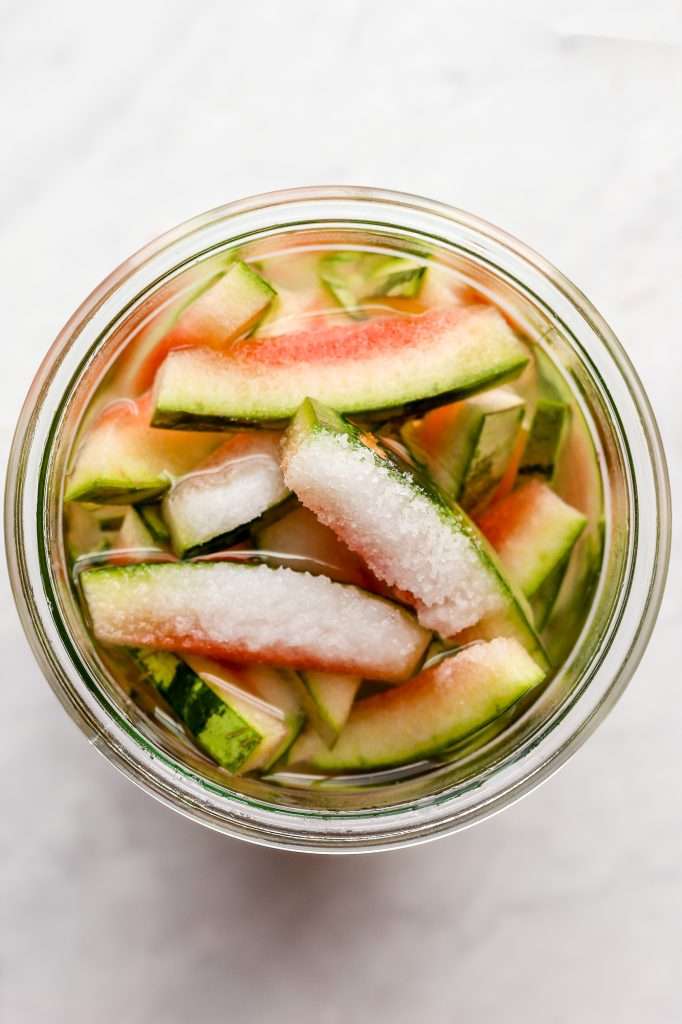
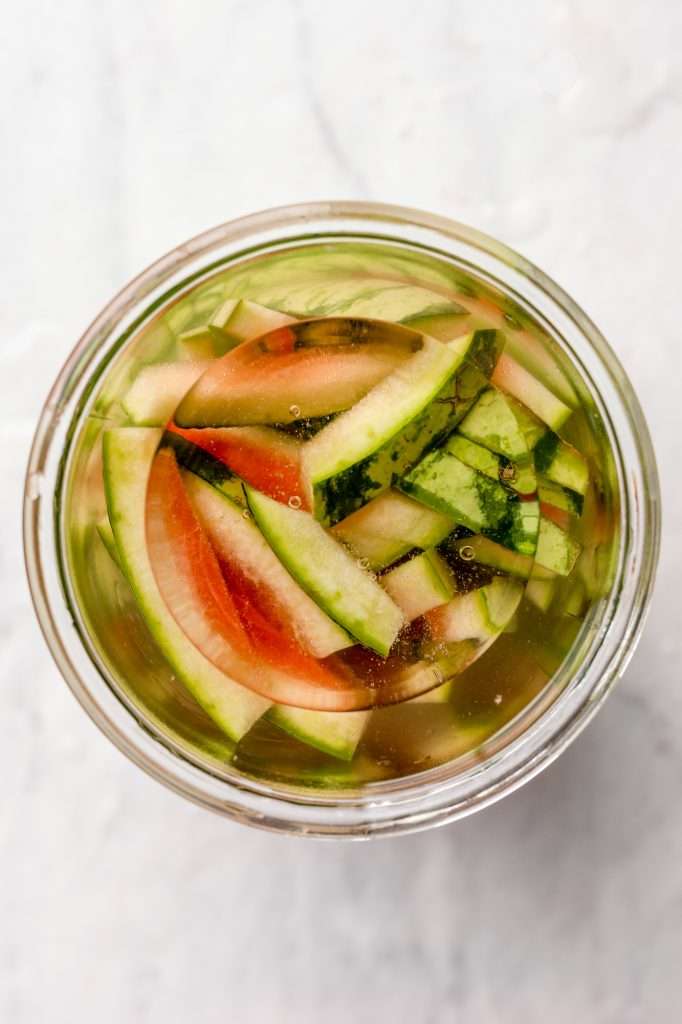
Probiotic Bacteria in Fermented Watermelon Rind
Similar to cucumbers, organic watermelons naturally have a lot of Lactobacillus plantarum on their surface. This means that watermelon rind ferments on a similar timeline to pickles. While cabbage takes four weeks to ferment, watermelon rind pickles take about two weeks.
You can ferment watermelon rind for longer if you want it to be more sour. The abundance of Lactobacillus makes fermented watermelon rind pickles excellent for gut health.

Preventing Sogginess When Fermenting Watermelon Rind
To help prevent sogginess, start with cold watermelon rind and a 3.5% total salt concentration. The most important thing you can do to keep any fermented pickles crisp is to use at least 3.5% total salt.
You can add bay leaves, sencha green tea, and grape leaves for tannins. Also, you can try adding calcium chloride salt, which is very effective at keeping things crunchy. (Some sources of calcium chloride are natural from limestone… and some are chemically produced. I suggest researching this salt and deciding if you’d like it in your food).
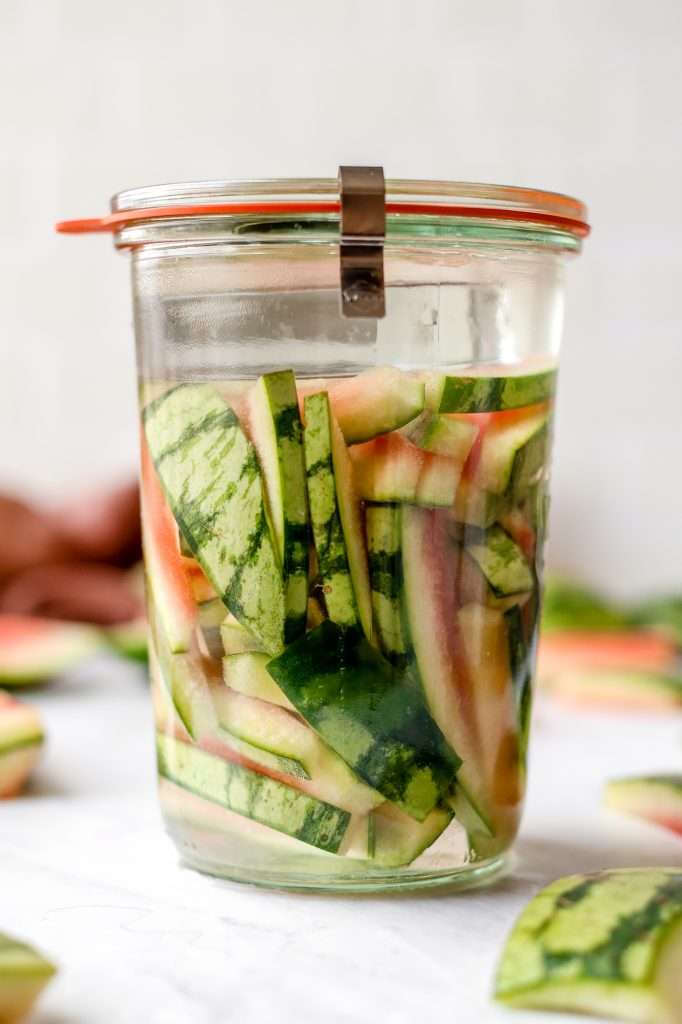
Supplies You Need to Make Fermented Watermelon Rind Pickles
Here is the equipment you will need to make it:
- 32-ounce Wide Mouth Mason Jar
- Fermentation Weight
- Standard Metal Mason Jar Lid (this can rust in the presence of salt)
- Try a Rust-Free Plastic Lid
- OR you can use a Weck Jar (without the gasket; only use the clips to secure the lid)
- Sea Salt
- Scale
- Mixing Bowl
- Ripple cutter
If you would like to read more about the best jars and lids for fermenting vegetables, click here.

Fermented Watermelon Rind Timeline
We tracked our fermented watermelon rind pickles throughout the fermentation process. If you follow our recipe and directions, your timeline for fermented watermelon rind should approximately match ours. This timeline is for fermenting at 72-78 degrees F. The process will be slower in colder conditions and faster in warmer conditions.
24 – 72 hours: All contents in the jar should be submerged beneath the brine. At this time, there are still Gram negative bacteria and possible pathogens present.
72 hours – 7 days: After 72 hours, you should start to see lots of bubbles. You need to burp the jar if you are using a standard mason jar and lid. The colors on the rind change from vibrant green to pale olive. You will also notice the brine becomes very cloudy. Leuconostoc bacteria begin to thrive and produce a lot of carbon dioxide and acetic acid. Gram negative organisms die off during this time.
7 – 12 days: Bubbles in the brine will decrease as the ferment leaves stage two and enters stage three. The mixture will become cloudy and start to develop a pleasantly sour smell. Lactobacillus species are most abundant during this time period.
12 – 14 days: Lactobacillus make up the majority or all of the microbial population. They produce copious amounts of lactic acid, and make the fermented watermelon rind smell even more pleasantly sour. This is the time in which the vegetable mixture becomes preserved. At this time, you can smell and taste test.
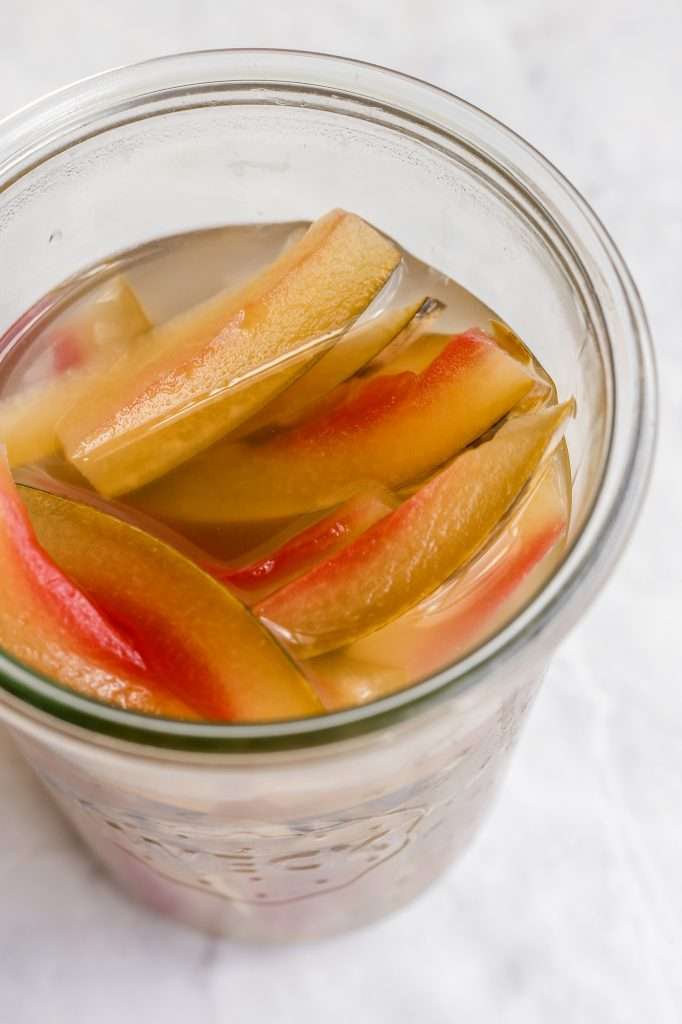
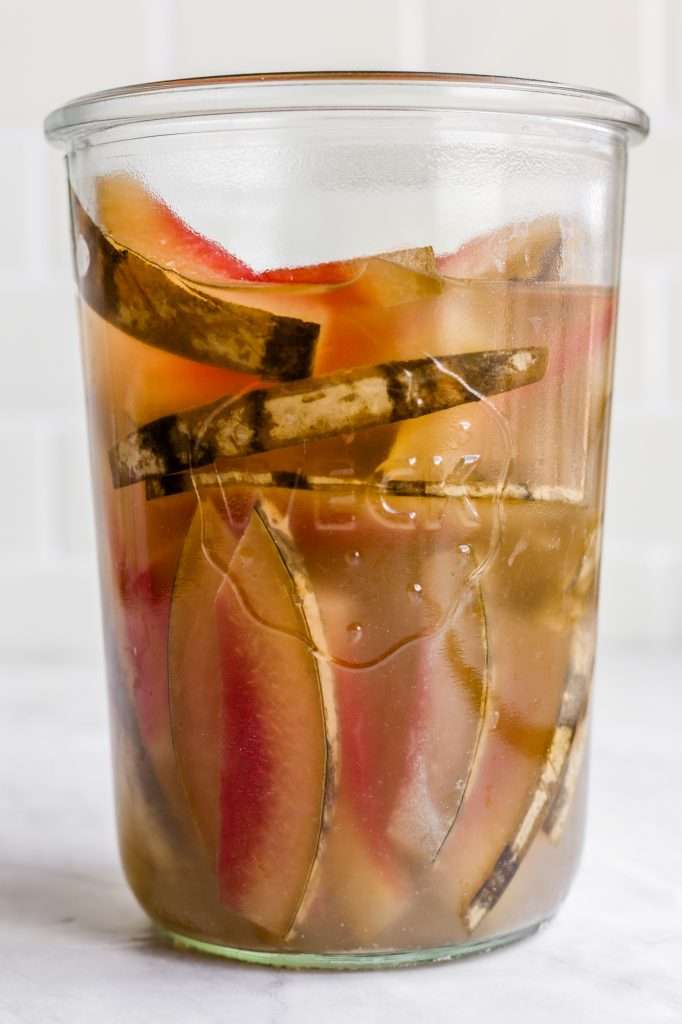
Fermented Watermelon Rind Pickles Recipe Tips
During the first few days of fermentation: carbon dioxide and bubbles will be produced. Sometimes jars will become full of liquid, and this liquid can seep out. You can store the jar in a bowl or on a plate to catch anything that seeps out.
Remove the lid and tamper everything using a gloved hand, tamper, or spoon if necessary. Make sure everything remains submerged below the brine during fermentation. You can take the lid off regularly and rinse it off if it is dirty.
Fermented watermelon rind should smell pleasantly sour and more smooth than a vinegar pickle. Never eat fermented foods that smell repulsive or like alcohol.
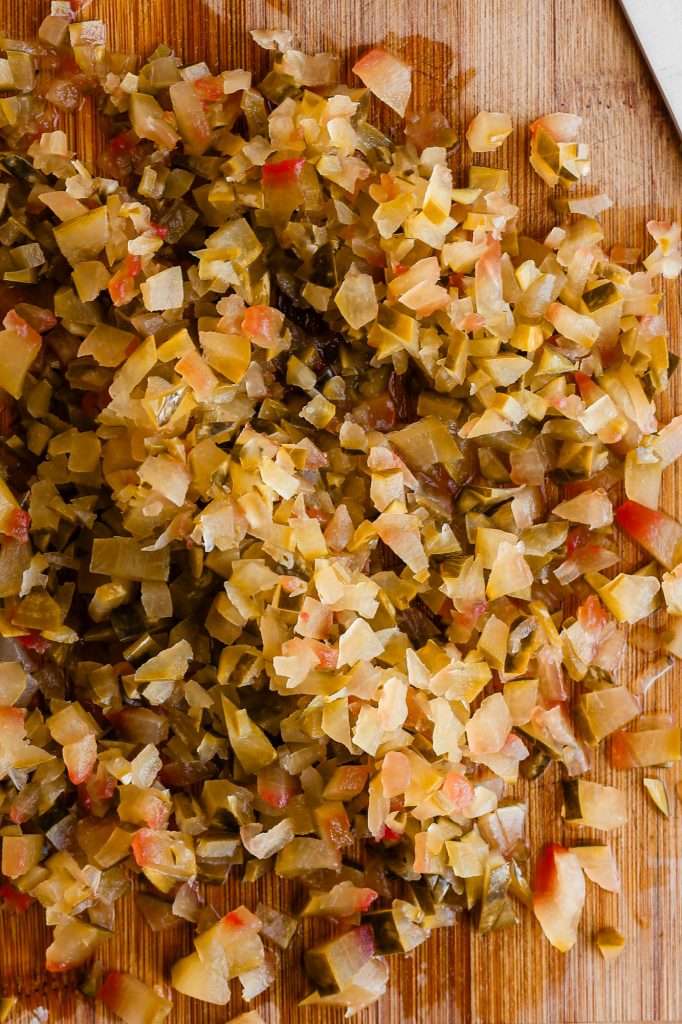

How to Eat It
The texture of the outermost peel on the rind can be chewy and weird. It is perfectly edible, but I suggest chopping the fermented watermelon rind and incorporating it into a fine, sweet relish for the most pleasant texture. It’s great for hot dogs.
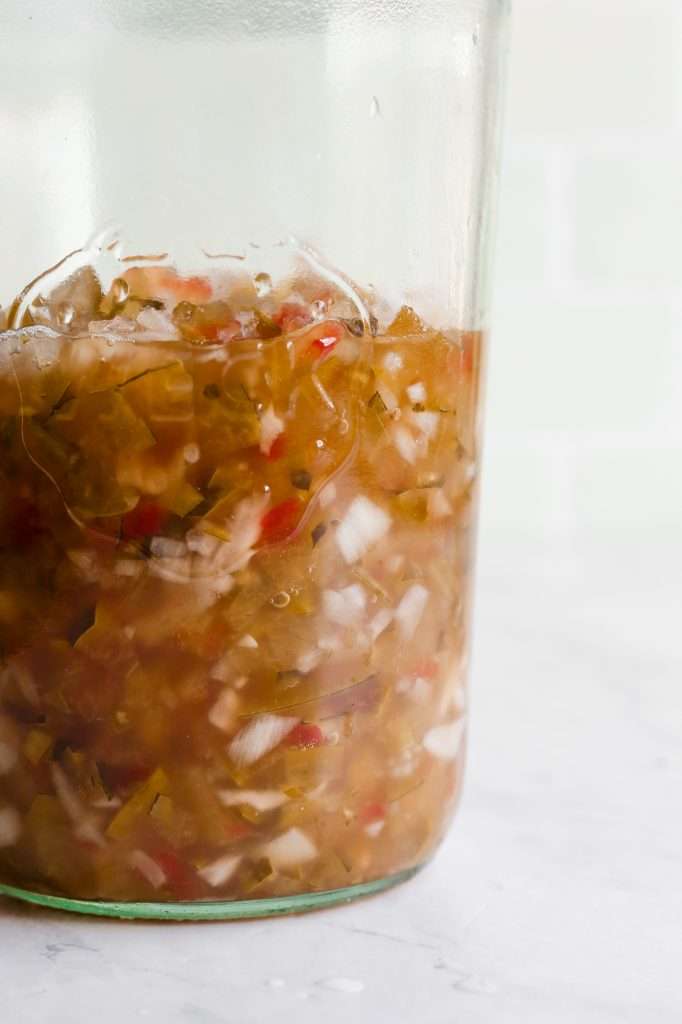
Sweet Fermented Watermelon Rind Relish with Onions
It’s best to chop it into a relish after fermentation because it’s easier to cut afterward. It’s also easier to submerge all the rind during fermentation if it is not finely minced.
Here is how to make it:
- Strain the rind out, reserve some brine, and finely mince all of the watermelon rind.
- Finely mince 1/2 a white onion.
- Mix the watermelon rind and white onion with 1/4 cup of red wine vinegar, two tablespoons of honey, and two tablespoons of reserved brine.
- Store in an airtight container and keep it in the fridge.
- Use this delicious relish on burgers, hot dogs, salads, and in chicken salad.

More Watermelon Recipes
- How to Make Watermelon Wine with Honey (Watermelon Mead)
- Watermelon Goat Cheese Salad with Strawberries and Basil
- Caprese Melon Salad with Prosciutto and Mozzarella


Fermented Watermelon Rind Pickles and Relish
It’s melon season, and this is the perfect recipe to use watermelon rind instead of wasting it! Fermented watermelon rind pickles are crisp, tart, and ready to eat in 14 days. Once the pickles are fermented, chop them up and turn them into a delicious sweet and sour fermented watermelon rind relish.
- Prep: 15 minutes
- Total Time: 336 hours 15 minutes
Ingredients
- 300 grams watermelon rind, chopped
- 400 grams water
- 25 grams sea salt
Instructions
- This recipe at 1x works best with a 32-ounce wide-mouth jar. Please see equipment recommendations above.
- Wash all of your fermentation equipment (jar, weight and lid)
- Wash your watermelon rind in cool water.
- Optional: peel the outer skin off the rind with a vegetable peeler. (After testing both peeled and un-peeled, I would recommend peeling for the best texture. The skin is a little chewy)
- Slice the rind however you would like. Slices are great, and you can easily finely chop the rinds into a relish after fermentation.
- Place your kitchen scale on the counter. Turn it on and set it to weigh in grams.
- Place a mixing bowl on your kitchen scale and tare/zero the scale.
- Weigh out the designated amount of watermelon rind.
- Add the rind and the designated amount of water to the jar.
- Place a small bowl on your scale and tare/zero the scale.
- Weigh out the salt. Then add salt to the jar of rinds and water.
- Add in any spices you want spices. (If using dry spices, you can avoid them floating to the surface. Place the spices in a small piece of cheesecloth or tea bag and tie it closed. Nestle the little spice pouch at the bottom the the jar, under the pieces fo rind. By doing this, you will still get all the flavor from the spices, without anything floating.)
- Place your standard mason jar lid on the jar, and secure it. Shake the jar vigorously for 2 minutes to dissolve all the salt.
- Remove the lid. Place your clean fermentation weight in the jar making sure to submerge the watermelon rind pieces and weight fully in the liquid.
- Secure the lid to the jar.
- Let the watermelon rind ferment for 14 days at room temperature. Set the jar in a glass dish to catch any spills.
- If using a sealing jar lid, you must burp the jar daily when it is bubbling.
- After 2 weeks, remove the fermentation weight and smell and taste test. Your fermented watermelon rind pickles should smell pleasantly sour. They should taste tart, sour, and salty.
- Store in the fridge once it is done fermenting. You can eat them as pickles or turn them into relish. Because of the texture of the watermelon skin, I prefer turning them into relish.
- To make the relish: Strain the fermented watermelon rind, reserve some brine, and finely mince all of the watermelon rind.
- Finely mince 1/2 a white onion.
- Mix the watermelon rind and white onion with 1/4 cup of red wine vinegar, two tablespoons of honey, and two tablespoons of reserved brine.
- Store in an airtight container and keep it in the fridge. Use this delicious relish on burgers, hot dogs, salads, and in chicken salad.





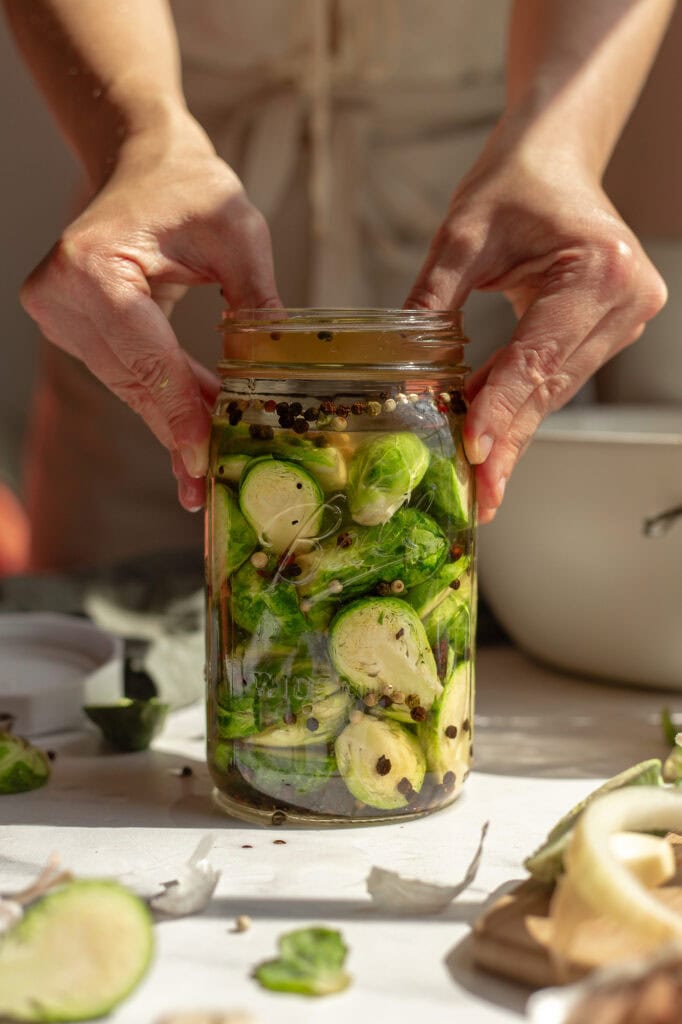













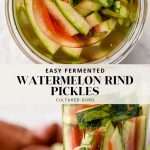

This relish was amazing. Watermelon is always in season in the Philippines so this relish will be a staple. I added some fermented chilis because I am a spice addict and subbed coconut vinegar for red wine, because that’s what I had. The recipes on this site are always on point! They’re obviously tested and perfected🤙
Oh, I need to try adding some fermented chilis to mine! Glad you enjoyed the recipe.
I am new at fermenting but I am loving it already. I pickled watermelon rinds per this recipe and also made the relish. It is delicious! I cannot wait to use it at our next cook out! Thanks for all your recipes and guidance 🙂
If you check online, you should notice that the parts of the watermelon are: skin, rind, and flesh. When ripe, the skin is green, rind is white, and the flesh is red.
I kinda forgot about my watermelon rind and let it ferment for approximately 28 days. There is now a white film on the top. It smells like sweet vinegar; no hint of alcohol. So many fine bubbles too, like a soda.
Do I have to scrap the whole thing?
Otherwise, this was such an easy recipe to follow and I have so many things currently fermenting from your other recipes. The hardest part is waiting!
Sounds like yeast. Should be harmless, but it really shouldn’t be bubbly still. Use your own discretion before eating. Did you use the jars I recommend and a fermentation weight?
Yes! I used the ball jars and glass fermentation weights. Maybe it continued to ferment like it would for sauerkraut? That’s why it’s so bubbly?
I don’t know if I’ll eat it now, it seems like a science experiment at this point haha!